Given the increased isolation, reduced access to social support, and limited access to resources that many families have experienced since the start of the pandemic, it is important to understand the significant impact these might have on families raising children and youth with special health care needs (CYSHCN).
CYSHCN require more health and related services than their peers. Some families with CYSHCN have always had challenges accessing these services; this is especially true for families who have children with medical complexity. These families also often face increased economic, educational, and health challenges. This report provides information on their experiences during the pandemic based on the Family Snapshot Survey.
One third (32%) of survey respondents identified having at least one child with special health care needs* in their household. Those respondents were asked to identify their child’s special needs.
This report also includes what was learned from virtual parent focus groups. Two focus groups were conducted in April 2021, each including 6 total participants. Participants were recruited through a series of Facebook advertisements aimed at parents of young children. Thirty-three participants were selected following a screening process consisting of a short survey; of these, 12 female parents aged 29 to 55 attended the focus groups, including parents of CYSHCN.
* For the Family Snapshot Survey, CYSHCN were defined as any of the following: a parent indicated that a child has special health care needs or indicated that their child requires medication, more medical care, mental health care, or educational services than are typical for children the child’s age.
Key Messages
- Despite the stress of the pandemic, most parents in households with at least one child with special health care needs have felt quite close or extremely close to their children – they cooked together, played together, and used positive discipline strategies.
- However, families in these households also experienced a number of challenges including high rates of disruption in day care, health care, and employment and loss of technological and therapeutic supports.
- Parents reported more intimate partner violence and spanking of children.
- About half of parents who reported feeling stressed most or all of the time also reported substance use: alcohol, cannabis, or other drugs.
- Pediatricians and pediatric health care providers might want to inquire about persistent challenges with child development and education, economic stress, and family stress even after the pandemic.
Disruptions to Families’ Lives
As noted in an earlier report, a major impact on families during the pandemic has been the disruptions to children’s daily lives. This is especially true for families with CYSHCN. More households with CYSHCN indicated disruptions compared with other households (92% vs 74%). Specifically, households with CYSHCN experienced higher rates of disruptions in child care or day care closures (24% vs 17%), canceled medical or dental appointments (45% vs 25%), and inability to receive free or reduced cost meals at school (18% vs 9%). One focus group parent highlighted how school disruption affected their child during the pandemic: “…it’s been more of the school situation, because she already has a delay with her learning so that kind of put her back… what she had already progressed [to], it’s kind of put her back.”
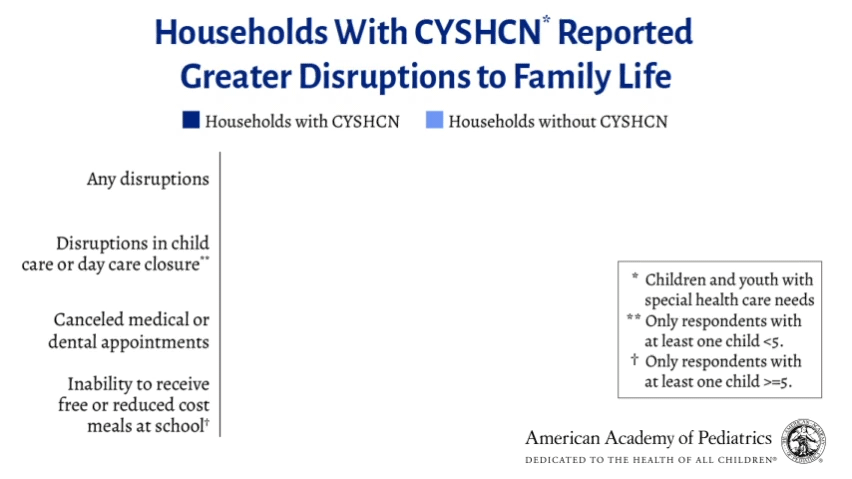
Families in households with CYSHCN experienced financial stress (41%) at similar rate as other families (37%). However, parents who were employed either full-time or part-time before the pandemic reported a higher percentage of change in employment in households with CYSHCN (61%) compared with other households (46%), indicating that parents from households with CYSHCN were laid off, furloughed, or reduced work hours at a higher rate. Fifteen percent of parents of CYSHCN reduced work hours to care for children or family, and female parents were more likely to reduce work hours compared with males (19% v 11%). The number of parents in households without CYSHCN reducing work hours to care for children or family was slightly lower at 10%.
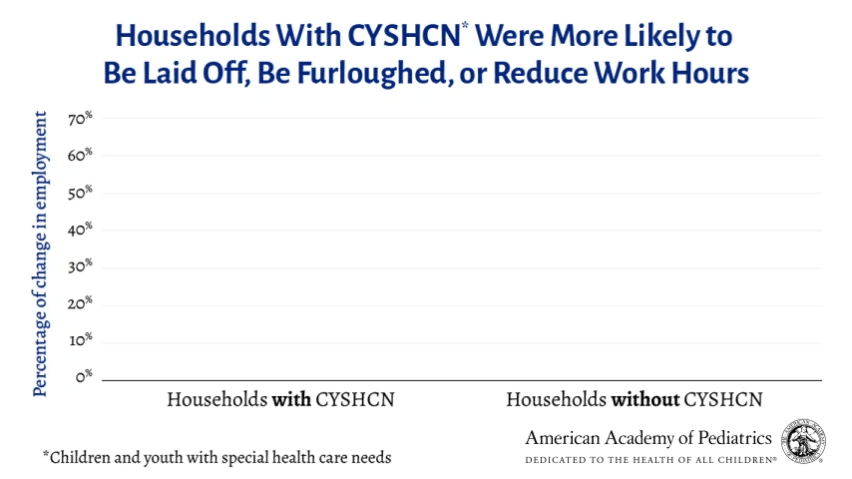
CYSHCN Access to Services and Family Stress
Most parents of CYSHCN accessed services both before and during the pandemic. These services include case management, care coordination, therapeutic care, social work, mental or behavioral health services, special education, and home nursing. Six percent of parents reported accessing these services for the first time during the pandemic, with mental and behavioral health services noted as the most newly accessed services.
Generally, parents reported feeling more overwhelmed during the pandemic than before the pandemic (21% vs 15%). Those who reported providing services to their child with special health care needs within 7 days of completing the survey were more likely to report feeling overwhelmed compared with those who did not provide these services. Provided services include hands-on support for therapeutic services WITH guidance from a therapist using technological supports (27% of those who provided these services reported feeling overwhelmed often compared with 18% of those who did not provide the services), providing hands-on support for therapeutic services WITHOUT guidance from a therapist using technological supports (30% of those who provided these services reported feeling overwhelmed often compared with 18% of those who did not provide the services), and providing supervision that would normally be provided by another individual (41% of those who provided these services reported feeling overwhelmed often compared with 18% of those who did not provide the services). In addition, parents were asked specifically how often they felt overwhelmed providing medical or therapeutic care before and during the pandemic.
As one focus group participant noted that the stress was magnified when family supports were also in short supply because of pandemic restrictions: The significant stress between me and my spouse both working from home while having a two-year-old with sensory and all this other challenging stuff and having a new sibling, has really taken a toll on, I think, everybody … It’s been hard to not have that extended family be able to come and help and just kind of lend their support.”
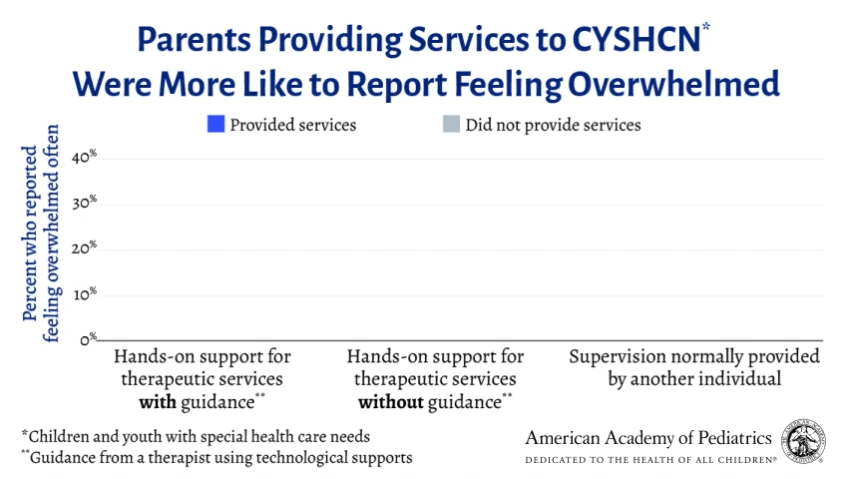
Responses to Increased Stress
Parental stress was associated with accessing certain services. Those who reported feeling nervous or stressed most/all the time were more likely to have accessed mental/behavioral health or social work services for their child during the pandemic compared with those who did not report these feelings (42% vs 32%).
Similarly, those who reported that helping children with medical care or therapeutic activities was stressful and not positive were more likely to have accessed mental/behavioral health services for their child during the pandemic compared with those who reported that the experience was positive (45% vs 35%).
Parents of CYSHCN reported using a variety of ways to relieve their stress. Of those who reported feeling nervous/stressed most of the time or always since the beginning of the COVID-19 pandemic, 51% reported using substances (alcohol, cannabis, other substance/drugs) as a stress-relieving activity, whereas 29% of those who did not report feeling nervous/stressed most of the time or always reported using substances (alcohol, cannabis, other substance/drugs) as a stress-relieving activity.
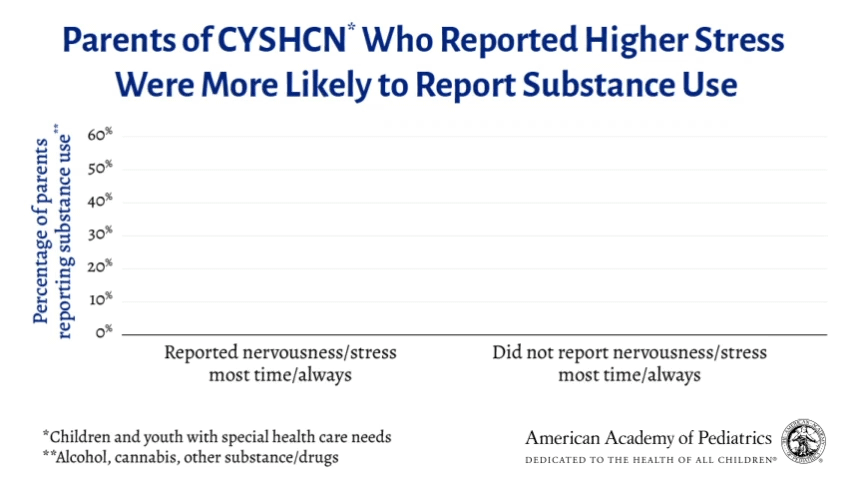
Child Safety
The number of parents in households with CYSHCN reporting family violence was higher than parents in households without CYSHCN. More parents in households with at least one child with special health care needs reported intimate partner violence (IPV) during the pandemic compared with other households (physical and/or emotional IPV: 30% vs 17%), physical IPV (17% vs 7%), and emotional IPV (26% vs 15%).
Despite the increase in family stress and IPV, most parents of CYSHCN had not spanked their children in the past week. Nevertheless, more (21%) had used spanking than parents without CYSHCN (14%).
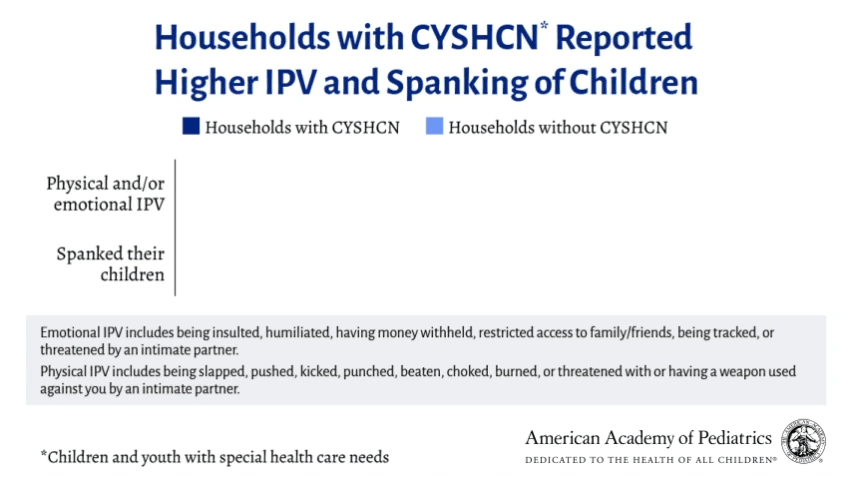
Impact on Children
Most parents in households with CYSHCN enjoyed positive experiences with their children. Similar to households without CYSHCN, parents in households with at least one child with special needs have done a variety of activities with their children in the 7 days prior to taking the survey, including watching TV or other media together (72%), cooking together (63%), and engaging in educational activities (53%). In addition, 71% of these parents have felt quite close or extremely close to their children since the start of the pandemic.
Consistent with the American Academy of Pediatrics (AAP) clinical guidance on Caring for Children and Youth With Special Health Care Needs During the COVID-19 Pandemic, the Family Snapshot Survey shows that CYSHCN are more likely to experience disruptions during the pandemic. Parents in households with CYSHCN reported more child disruptions such as those in day care and health care. Pediatricians should take care to address the elevated impact of these disruptions on CYSHCN and their families. The AAP suggests that health care providers initiate contact with these families, coordinate health needs primarily through telehealth, and make accommodations for in-person visits when necessary.
With many caregivers stating they are feeling overwhelmed with providing medical and therapeutic care and with stress from negative economic impacts, it is important that providers address not only the mental health of CYSHCN but also the mental health needs of their caregivers, connecting families to appropriate supports including peer-to-peer support through family-led organizations.
Both spanking and IPV were higher in families with CYSHCN. One-fifth of parents in households with at least one child with special health care needs reported spanking their children in the past week, and about one-third reported experience of IPV during the pandemic. Health care providers should ask about family relations and the safety of everyone in the household.
Families with CYSHCN faced greater challenges and disruptions to daily life prior to the pandemic compared with families that do not have CYSHCN. Conditions of the pandemic have magnified these challenges. Acknowledging these difficulties might be a first step in starting a discussion with families about parenting during the pandemic and supporting families with resources to encourage positive parenting.
Resources for Pediatricians
Last Updated
08/27/2021
Source
American Academy of Pediatrics